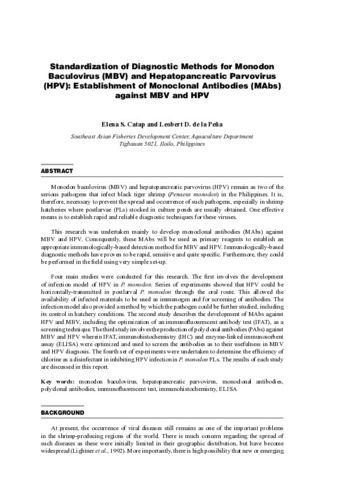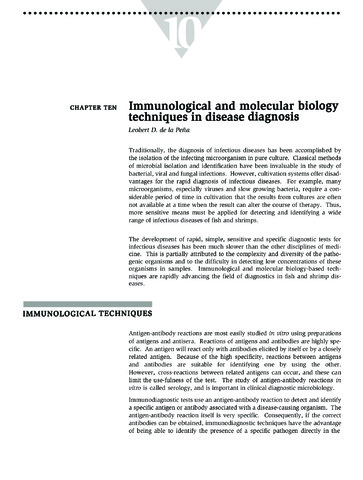Perlihatkan publikasi sederhana
Production of polyclonal antibodies (PAbs) against monodon baculovirus (MBV) and hepatopancreatic parvovirus (HPV)
| dc.contributor.author | Catap, Elena S. | |
| dc.contributor.author | de la Peña, Leobert D. | |
| dc.contributor.editor | Nagasawa, Kazuya | |
| dc.date.accessioned | 2020-07-21T01:19:17Z | |
| dc.date.available | 2020-07-21T01:19:17Z | |
| dc.date.issued | 2005-03 | |
| dc.identifier.citation | Catap, E. S., & de la Peña, L. D. (2005). Production of polyclonal antibodies (PAbs) against monodon baculovirus (MBV) and hepatopancreatic parvovirus (HPV). In K. Nagasawa (Ed.), Recent Advances in Diagnosis and Prevention of Fish and Shrimp Diseases in Southeast Asia (pp. 45–50). Tigbauan, Iloilo, Philippines: Aquaculture Department, Southeast Asian Fisheries Development Center. | en |
| dc.identifier.isbn | 9718511732 | |
| dc.identifier.uri | http://hdl.handle.net/10862/5911 | |
| dc.description.abstract | Monodon baculovirus (MBV) and hepatopancreatic parvovirus (HPV) are two of the viral pathogens, which infect penaeid shrimps in the Philippines. Polyclonal antibodies (PAbs) to MBV and HPV were raised by immunization of rabbits with the purified virions. The antisera produced were assessed using immunofluorescence antibody test (IFAT), indirect enzyme-linked immunosorbent assay (ELISA) and immunohistochemistry (IHC). IFAT showed intense fluorescent reactions in impression smears and paraffin-embedded sections of MBV-infected P. monodon postlarvae (PLs) but not in smears and/or sections infected with HPV or WSSV. Similarly, IHC tests showed positive coloration in MBV-infected cells but not in sections with either HPV or WSSV. Indirect ELISA test revealed that the PAbs could detect 4 ng (rabbit 1) and 100 ng (rabbit 2) of purified MBV. However, testing of crude shrimp homogenates by indirect ELISA indicated high level cross-reactions (gills of WSSV-infected adult P. monodon, head portions of HPV- and MBV-infected PLs and non-infected PLs). Screening of anti-HPV serum likewise showed intense immunofluorescence and positive red brownish coloration in HPV-infected sections. However, there were also strong cross-reactions observed in sections of hepatopancreas with MBV infection. Overall, the MBV PAbs developed have potential application in the detection of the virus. Further purification of the PAbs is required to minimize background and/or cross-reactions. | en |
| dc.language.iso | en | en |
| dc.publisher | Aquaculture Department, Southeast Asian Fisheries Development Center | en |
| dc.subject | polyclonal antibodies | en |
| dc.subject | Baculovirus | en |
| dc.subject | Penaeus monodon | en |
| dc.title | Production of polyclonal antibodies (PAbs) against monodon baculovirus (MBV) and hepatopancreatic parvovirus (HPV) | en |
| dc.type | Book chapter | en |
| dc.citation.spage | 45 | en |
| dc.citation.epage | 50 | en |
| dc.citation.bookTitle | Recent Advances in Diagnosis and Prevention of Fish and Shrimp Diseases in Southeast Asia | en |
| dc.subject.asfa | animal diseases | en |
| dc.subject.asfa | shrimp culture | en |
| dc.subject.asfa | viral diseases | en |
| dc.subject.asfa | infectious diseases | en |
| dc.subject.asfa | disease recognition | en |
| dc.subject.asfa | DNA | en |
| dc.subject.asfa | monoclonal antibodies | en |
| dc.subject.asfa | immunization | en |
| dc.subject.asfa | immunofluorescence | en |
| dc.subject.scientificName | Penaeus monodon | en |
Files in this item
Publikasi ini ada di koleksi berikut
-
Recent Advances in Diagnosis and Prevention of Fish and Shrimp Diseases in Southeast Asia [43]
Terminal Report of the Regional Fish Disease Project on “Development of Fish Disease Inspection Methodologies for Artificially-Bred Seeds” Funded by the Government of Japan Trust Fund from 2000 to 2004


 AQD Access only
AQD Access only


